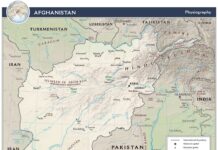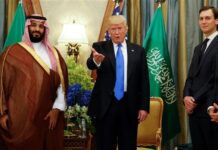Context
.gif) Two contrasting narratives have emerged on understanding the dynamics of unrest in the Arab world. The primary argument supports the notion these revolutions are not linked to each other while the other holds they are. This article examines both angles to understand what’s taking shape in Yemen, Bahrain, Syria, Egypt, and Libya.
Two contrasting narratives have emerged on understanding the dynamics of unrest in the Arab world. The primary argument supports the notion these revolutions are not linked to each other while the other holds they are. This article examines both angles to understand what’s taking shape in Yemen, Bahrain, Syria, Egypt, and Libya.
Analysis
In an essay ‘Themes and Variations’ in the Islamic world published in 1982, Former Deputy Assistant for US State Department Philip H. Stoddard, from the Bureau of Intelligence and Research, put the challenge in the Muslim world this way:
“The turbulence in the Muslim world makes even more important our need to examine carefully the processes of reaction and adjustment to external and internal stimuli that have been so greatly been influenced by religion, tradition, and, in many cases, the colonial experience. “
The conventional interpretation of the unrest unfolding in the Middle East and North Africa has pointed to the country-specific social and political underpinnings that may have received a boost from the phenomenon of social media. A necessary prerequisite to grasp the present situation in the region is to look at the interests and threat perceptions of key stakeholders. Equally, it’s crucial to study the following factors:
- What connects the region and what divides it.
- Forces of change and status quo in the Arab world and the politics of emerging powers.
What Connects and Divides the Region
Most contemporary analysis of events in the Arab world tend to consider the situation through the prism of present nation-state classification, which has existed since the end of Word War II. And, as they do that, they see each country based on its own dynamics. However, there is a need to understand the region through the perspective of history before arriving at any definitive conclusion. It should me remembered that the existing order of the Middle East and North Africa emerged from the ashes of Ottoman Empire. It’s no surprise that resurgent Turkey is once again playing an prominent role in matters related to the Muslim world.
This historical examination would also reveal significant clues to why the Europeans were so eager to move on Libya. And it may have to do with establishing spheres of influence, as the Arab world goes through popular revolts, and the West through recession. Spheres of influence become a necessity, if after revolts, the Arab countries start reverting to their earlier tribal formulations once again.
The points of connectivity in the region include common faith, language, and geography. However, there are different tribes and sects of religion, which divides the region and results in tussles such as the Shiite-Sunni one. These differences were valuable tools in the hands of colonial powers, and still are used by regional and global powers.
Another classification to comprehend the region is to look at it from the view of ‘resource rich’ and ‘resource poor’ countries. Since 911, Global War on Terror has been more active in resource poor countries of the region. Extremists have generally used the resource-starved areas as safe havens from where to destabilize the resources rich countries, which are in turn allied with and dependent on the western powers for security. Additionally, emerging and established powers are dependent on the energy resources of these countries, and therefore stability and easy access is crucial.
Monarchs and autocrats have ruled most of these resource rich and economically weak countries in the region, which is also a trait the Arab nations share. These autocrats have usually spent a lot of time and resources on self-preservation and have used religion for politicking. In the long run, this has seriously dented the credibility of the Sunni autocrats of the region. Furthermore, in the aftermath of the Peace Flotilla incident last year, the balance of power in the region and the Islamic world decisively shifted in favor of Turkey and Iran, because of their strong posture against Israel.
The Forces of Change and Status Quo in the Region
As described above, since World War II, the monarchs and autocrats of the region have depended on the West and the former Soviet Union, to preserve their reign and status quo. With the end of Cold War, the West became the principal force simultaneously pushing these governments for reform while providing legitimacy these autocrats needed to maintain the status quo. This gave western powers unique influence in the region, as it could push and pull either force based on its interest.
However, recently Al Qaeda and the emerging powers of BRIC (Brazil, Russia, China, India) have challenged the existing order in the region. BRIIC nations have generally been supportive of the US and NATO led campaign against the extremists, especially in Iraq and Afghanistan. However, Russia and China have particularly watched with considerable concern the encroachment of NATO alliance in to their traditional spheres of influence. These apprehensions caused BRIC nations to abstain from the vote on UN Security Council resolution 1973, enforcing no-fly zone over Libya.
As a general rule, emerging powers avoid confrontations with the established powers, until its just unavoidable. On the other hand, the established powers usually side with some of the emerging powers to check the advance of others. Therefore, it is essential to understand how the tussles of emerging and established powers are once again developing a pull and tug, in different regions of the globe, under various garbs.
Conclusion
In this context, the Egyptian, Tunisian, Libyan, Bahraini, Yemeni, and Syrian uprisings are not so disconnected.
From the threat perception of Saudi Arabia and other Gulf countries, unrest in Yemen and Bahrain is a grave risk to their regimes, and may have an Iranian hand in it. On the other hand, the Syrian revolt could be seen as a counter move to break the Iran-Syria-Lebanon-Hezbollah-Hamas nexuses and benefits Israel, western interests, and the Sunni Gulf rulers.
With US military already preoccupied in Iraq and Afghanistan, Middle East Peace Process deadlocked, and with extremists spreading their influence, status quo no longer appears to be a viable option for the Americans. The social media assisted revolutions provide an opportunity to shape the region anew and counter adversaries. However, this makes the Gulf monarchs and emerging powers extremely wary of American intentions.
The events unfolding in Libya are unnerving for both Russia and China. To them NATO is attempting to estblish another foothold in the region. Furthermore, events of Libya have also exposed competetion between Germany, France, Russia and UK, the dynamics that is also complicating NATO’s Afghan mission.
Israel-Palestinian conflict is the most dangerous connection these Arab revolts have. So far the revolt on the Arab street has not been anti-American or against Israel. Nonetheless, recent uptick in rocket attacks from Gaza in to Israel and the bomb blast in Jerusalem last week, was widely interpreted as an attempt by Egyptian Muslim Brotherhood or Iran, to shift the focus of the popular unrest toward a common cause. Meanwhile, Israel is strongly projecting the Shiite-Sunni conflict of the Arab and Islamic world, and keep the spotlight away from itself.



